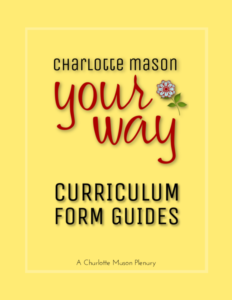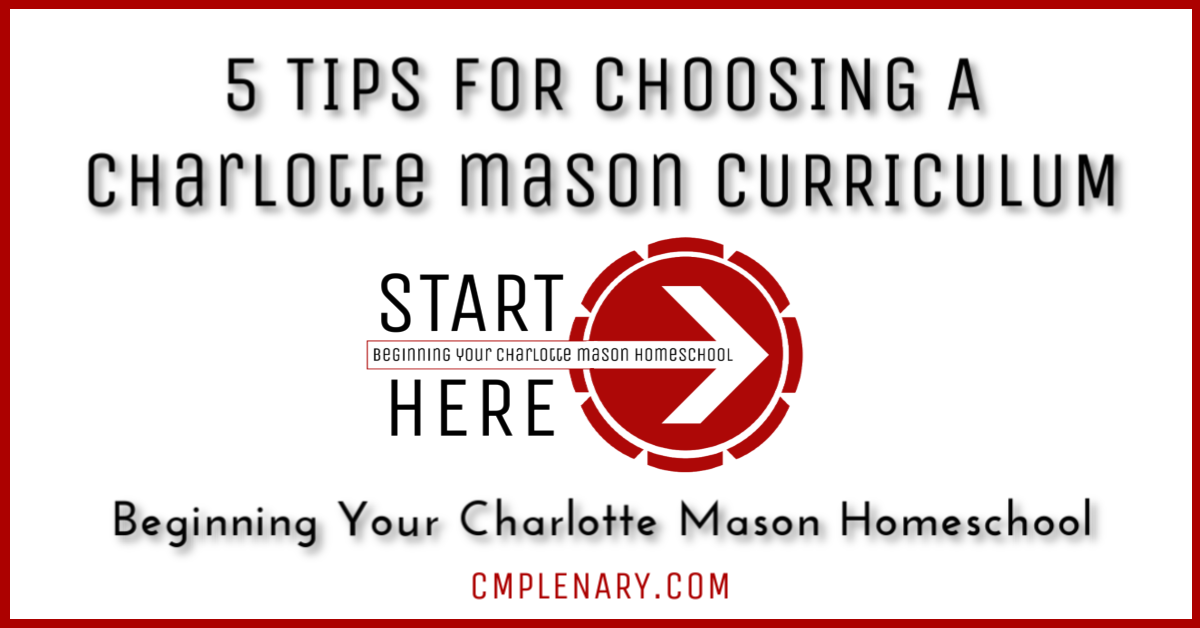WHAT TO LOOK FOR IN A
CHARLOTTE MASON CURRICULUM
I frequently get asked about various CM curricula and the other day I ran across a quote in Principle #7 of our 20 Principles Study where Charlotte says:
“The intellectual habits of the good life form themselves in the following out of the due curriculum in the right way.” -Charlotte Mason, Volume 6, pg. 99
So first Charlotte says that simply using her Curriculum will help establish good intellectual habits, but only if we use it IN THE RIGHT WAY.
Now, there is no shortage of CM homeschool curricula available to the modern homeschooling mom – from “CM-Purist” to “CM-Inspired.” What would Charlotte think about the various offerings available to us today?
And what exactly makes a curriculum a Charlotte Mason curriculum? There are SO MANY out there – what should you be looking for? How can you evaluate each one of them and find the one that is the right fit for your family?
I suggest that there are 5 main questions you should ask yourself when evaluating whether or not a curriculum truly is Charlotte Mason.
YOU CAN ALSO WATCH A VIDEO ON THIS TOPIC HERE
5 questions to ask yourself
when choosing a CM Curriculum
First, let’s look at Charlotte’s original curriculum: the PNEU PROGRAMMES.
Every year, the curriculum for each Form would be printed in a Programme published by the PNEU, or the Parent’s National Educational Union.
If you were a school or a family enrolled in PNEU, you would get a Programme in the mail for each Term. These Programmes were small booklets which listed every subject covered in a given Form as well as
- what books were to be used by the students
- what books were to be used by the teachers
- instructional comments for each subject
- exam questions for each subject
You can see examples of several of Charlotte’s Programmes from the 1922-1923 school year here:
- Programme 94 Form 1 (Grades 1-3)
- Programme 94 Form 2 (Grades 4-6)
- Programme 94 Form 3 (Grades 7-8)
- Programme 94 Form 4 (Grade 9)
Or you can search for them on Worldcat.org or Archive.org under the Charlotte Mason Digital Collection.
So the first question to ask yourself when evaluating a CM curriculum is:
#1: DOES IT FOLLOW CHARLOTTE MASON'S PROGRAMMES?
In other words, does it incorporate all the subjects that Charlotte assigned to each particular Form?
Not just subjects like history, literature, and geography, but other subjects like handicrafts, nature study, picture study, folk songs, etc.
These are the types of subjects that I call JOY SUBJECTS, and they are exactly the kinds of things that are missing from a curriculum isn’t following the Programmes. And besides, who would want to leave out anything that would add a little more JOY to our days? Not me!
But other subjects like citizenship and Shakespeare tend to get left out as well.
But then the opposite is also true… non-CM curricula tend to ADD subjects where Charlotte did not. This most often includes grammar and spelling in the early elementary years. Charlotte believed grammar to be a concept that is too abstract for younger children, so she waited until Form 2 to add it. And spelling is incorporated into copywork and dictation in Form 2 as well. It is not a separate subject.
So FIRST it’s important to evaluate a CM curriculum by what subjects are covered and what subjects are NOT covered. .
But what about the second part of Charlotte’s statement:
“There is but one right way, that is, children must do the work for themselves. They must read the given pages and tell what they have read, they must perform … the act of knowing.” -Charlotte Mason, Vol. 6, pg 99
So what is THE RIGHT WAY to follow the curriculum? Here, she’s talking about the METHOD. And that brings us to the next question:
#2: DOES IT FOLLOW CHARLOTTE'S METHOD?
Is it apparent that the creators of the curriculum have read Charlotte’s original volumes? Is it evident in the curriculum that the creators understand Charlotte’s method?
Does it allow the student to “do the work for themselves” without the teacher getting in the way?
No lectures, no unit studies… the students must make their own connections.
And does it incorporate things like the use of narration, or “the act of knowing,” which is such a crucial part of the CM method?
And – here’s QUESTION #3:
#3: DOES IT INCORPORATE THE USE OF LIVING BOOKS AND NARRATION?
Because you cannot tell what you don’t know – and you can’t narrate if you aren’t using living books!
You’ve probably heard a LOT of discussion in CM circles about Living Books. This is a point that often gets confused with “literature-based learning.” Let me make this clear:
LITERATURE-BASED DOES NOT EQUAL CM!
In fact, Charlotte only assigned 1 or 2 true “literature” books per semester! And her students read those books VERY SLOWLY! And the same is true for books used in other subjects… they did NOT fly through book after book!
Her method of slow reading allows the student to “sit” with the information he’s just read – to think about it, mull over it, ponder it.
Students need time to assimilate their readings.
Which brings me to QUESTION #4:
#4: Does it follow Charlotte’s scheduling regarding the Frequency and Length of Lessons?
Frequency of Lessons refers to the scheduling of books – the time in-between readings.
Students using the CM method do read a LOT of books – but they will usually only read any given book once, maybe twice, per week.
If you see a CM curriculum that schedules the same book more than once or twice a week, it isn’t taking into account Charlotte’s method of slow and deliberate reading
And the next point is Length of Lessons – Charlotte was a big believer in keeping lessons short!
This is to ensure that a student can attend, or pay attention, to the lesson without fatiguing. It’s meant to keep the brain fresh and focused!
Lessons in Form 1 ranged anywhere from 5 minutes to 20 minutes MAXIMUM! And Charlotte always said you should watch the child rather than the clock to tell you when the lesson should end.
Which brings me to QUESTION #5 – and probably the most important question of all:
#5: Does the curriculum fit your family?
Does a pre-written curriculum look like it will work for your children? Or can you tweak it to fit your family’s needs? Does it give you the tools (and the permission) to customize the curriculum for your family?
I’ve tried a few different CM curricula over the years and I always came back to creating my own curriculum for my children.
And YOU CAN DO IT too! After all, you know your children better than anyone!
That’s why I created the Charlotte Mason Your Way Curriculum Form Guides – to give you the tools you need to create a custom curriculum for your family. 
The Guides are divided by Forms and each Guide walks you through three very important steps:
STEP #1, the OVERVIEW OF FORM SUBJECTS, walks you through Charlotte’s Programmes for that Form, showing you exactly what subjects were taught and what books were used… as well as info and instructions on how to teach each subject.
STEP #2 is THE CHARLOTTE MASON YOUR WAY QUIZ, which shows you how to customize your curriculum and your schedule to fit your family’s needs.
And STEP #3 helps you CREATE A CUSTOM SCHEDULE and get it down on paper – a schedule that will set you up for success.
Then, there’s an unofficial bonus STEP #4 that helps you select the LIVING BOOKS AND RESOURCES that you will need for your custom curriculum.
It really is that simple!
It Should be About Simplicity & Beauty
How does the curriculum affect the atmosphere of your home?
The Charlotte Mason method is about Simplicity and Beauty. And a CM Curriculum should not make you or your children feel overwhelmed, pressured, or feel like you’re drowning!
Whether you decide to use a pre-made curriculum, or create your own – it should be relaxed and simple and beautiful. It should equal less stress and MORE JOY in your homeschool.
With a Charlotte Mason education, THE WHOLE IS GREATER THAN THE SUM OF ITS PARTS. All these pieces work together like a puzzle to give our children a broad and generous curriculum – after all,
“The question is not — how much does the youth know? when he has finished his education — but how much does he care? and about how many orders of things does he care? In fact, how large is the room in which he finds his feet set? and, therefore, how full is the life he has before him?” – Charlotte Mason, Vol. 6, p. 170-171
We all want to give our children the best education and the fullest life possible.
No matter what you decide, it will be the right choice for your family at this time. Those choices will change and grow – as life always changes and grows.
DOWNLOAD THE CHECKLIST HERE
5 Questions to Ask Yourself
When Choosing a CM Curriculum
Yay! Thank you!
I hope this article (and video) has been helpful and encouraging to you. I made a checklist of the five questions for you to download if you would like a printable version.
If you have any questions, feel free to post them here or in The Plenary Facebook Group. And if you enjoyed this article and know another homeschool mom who might benefit from it, please share it.
I hope to chat with you soon!

I looked over The Programme for Form 1. Was pleasantly surprised that the father was included in the examinations!